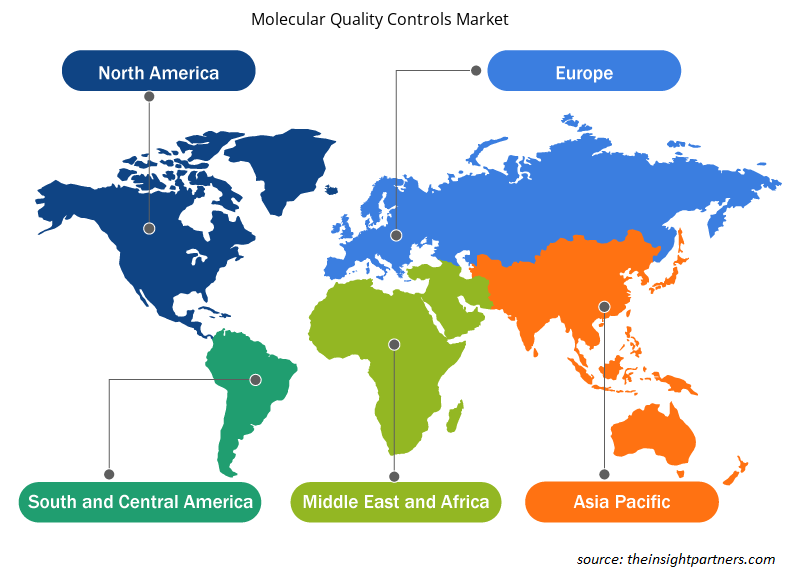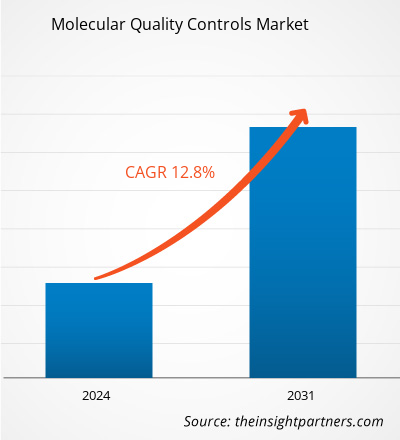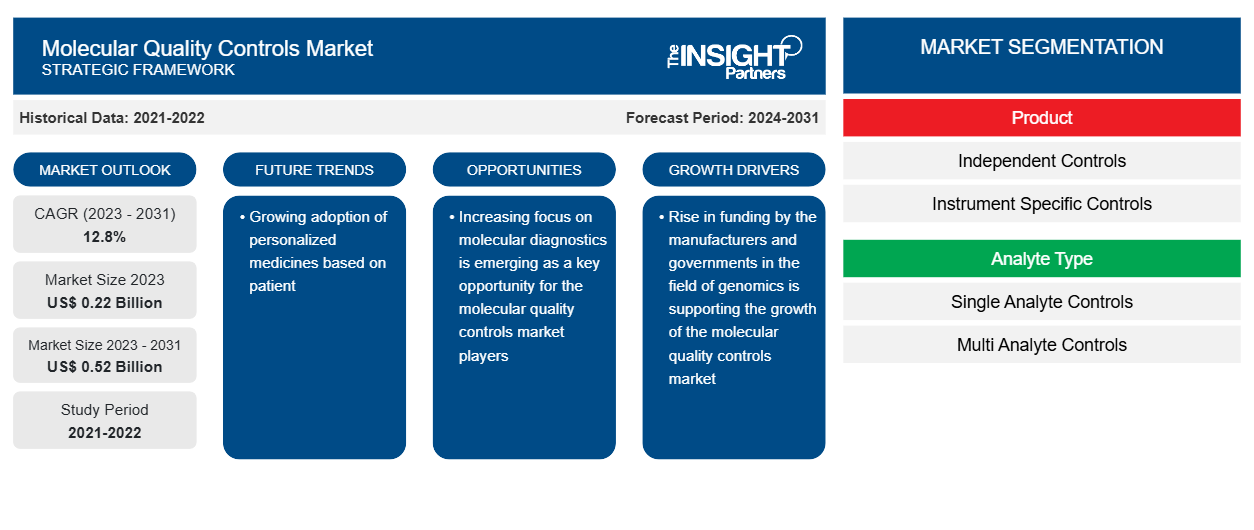من المتوقع أن يصل حجم سوق ضوابط الجودة الجزيئية إلى 0.52 مليار دولار أمريكي بحلول عام 2031 من 0.22 مليار دولار أمريكي في عام 2023. ومن المتوقع أن يسجل السوق معدل نمو سنوي مركب بنسبة 12.8٪ خلال الفترة 2023-2031. ومن المرجح أن يظل الطلب المتزايد على الأدوية المخصصة اتجاهًا رئيسيًا في السوق.
تحليل سوق ضوابط الجودة الجزيئية
إن عوامل مثل زيادة الأموال المخصصة لعلم الجينوم وزيادة انتشار الأمراض الوراثية تعمل على تغذية نمو السوق. وعلاوة على ذلك، فإن التركيز المتزايد على التشخيص الجزيئي يشكل فرصة رئيسية للاعبين في سوق مراقبة الجودة الجزيئية.
نظرة عامة على سوق ضوابط الجودة الجزيئية
كان تسلسل الجينوم مقتصرًا على مرافق البحث قبل بضع سنوات. ومع ذلك، فقد أصبح الآن أحد التقنيات القياسية في الممارسات السريرية. وفقًا للدراسة "دمج الجينوم في الرعاية الصحية"، من المتوقع أن ينتج قطاع الرعاية الصحية على مدار السنوات القليلة القادمة بيانات جينومية لأكثر من 60 مليون مريض. يتم دعم التنفيذ المتزايد لتسلسل الجينوم في أنظمة الرعاية الصحية من خلال استثمارات حكومية كبيرة، يبلغ مجموعها أكثر من 4 مليارات دولار أمريكي في 14 دولة على الأقل. أعلنت المملكة المتحدة عن أكبر مشروع جينوم في العالم كجزء من تعاون بين القطاعين العام والخاص بقيمة 200 مليون دولار بين المنظمات الخيرية وشركات الأدوية .
قم بتخصيص هذا التقرير ليناسب متطلباتك
ستحصل على تخصيص لأي تقرير - مجانًا - بما في ذلك أجزاء من هذا التقرير، أو تحليل على مستوى الدولة، وحزمة بيانات Excel، بالإضافة إلى الاستفادة من العروض والخصومات الرائعة للشركات الناشئة والجامعات
-
احصل على أهم اتجاهات السوق الرئيسية لهذا التقرير.ستتضمن هذه العينة المجانية تحليلاً للبيانات، بدءًا من اتجاهات السوق وحتى التقديرات والتوقعات.
محركات وفرص سوق ضوابط الجودة الجزيئية
تزايد انتشار الأمراض الوراثية
نظرًا لأن ضوابط الجودة الجزيئية تسهل تفسير النتائج، فإنها تُستخدم في الكشف عن الاضطرابات الوراثية. إن النسخة الكاملة أو الجزئية الإضافية من الكروموسوم 21 هي الانقسام الخلوي الشاذ الناتج الذي ينتج المرض الوراثي المعروف باسم متلازمة داون. وفقًا لمراكز السيطرة على الأمراض والوقاية منها في الولايات المتحدة، يولد حوالي 6000 طفل في الولايات المتحدة مصابين بمتلازمة داون كل عام. نتيجة لذلك، تزداد الاختبارات قبل الولادة لمتلازمة داون على مستوى البلاد.
يحدث تحور في جينين، BRCA1 (جين سرطان الثدي الأول) وBRCA2 (جين سرطان الثدي الثاني)، في أغلب حالات سرطان الثدي الوراثية. ووفقًا للجمعية الأمريكية للسرطان، فإن الجينات المعيبة التي تنتقل من الآباء إلى الأبناء تشكل ما بين 5% إلى 10% من حالات سرطان الثدي الوراثية. ويزداد انتشار الاختبارات الجينية للكشف عن سرطان الثدي الوراثي مع تزايد الوعي بسرطان الثدي.
ارتفاع في اعتماد التشخيص الجزيئي
تُستخدم مناهج التشخيص الجزيئي للكشف عن الاضطرابات بين تسلسلات محددة في الحمض النووي أو الحمض النووي الريبي. تؤدي المخالفات مثل تعدد أشكال النوكليوتيدات المفردة (SNP) والحذف وإعادة الترتيب والإدراج إلى أمراض مختلفة - مثل الأمراض المعدية والسرطان والأمراض الفيروسية والأمراض المنقولة جنسياً (STDs).polymorphism (SNP), deletions, rearrangements, and insertions lead to various diseases—such as infectious diseases, cancer, viral diseases, and sexually transmitted diseases (STDs).
وفقًا لتقرير حقائق وإحصائيات الإنفلونزا، خلال عامي 2017 و2018، كان هناك حوالي 31.4 مليون زيارة للمرضى الخارجيين بسبب الإنفلونزا. وذكر أيضًا أن 5-20٪ من سكان الولايات المتحدة يصابون بالإنفلونزا كل عام. وعلاوة على ذلك، وفقًا للمعهد الوطني للسرطان، في عام 2020، سيتم تشخيص حوالي 1،806،590 حالة إصابة جديدة بالسرطان في الولايات المتحدة، مع تقدير عدد الوفيات بنحو 606،520. ومن المتوقع أن يرتفع عدد الأشخاص المصابين بالسرطان إلى 19 مليونًا بحلول عام 2024. يؤدي هذا الانتشار المرتفع للأمراض المعدية وزيادة حالات الإصابة بالسرطان إلى زيادة الجذب نحو التشخيص الجزيئي، لأنه قادر على تشخيص الأمراض بدقة عالية، مما يمهد الطريق لعلاج المرضى بالطب الدقيق.
تقرير تحليل تجزئة سوق ضوابط الجودة الجزيئية
إن القطاعات الرئيسية التي ساهمت في استخلاص تحليل سوق ضوابط الجودة الجزيئية هي المنتج والتطبيق والمستخدم النهائي.
- بناءً على المنتج، يتم تقسيم سوق ضوابط الجودة الجزيئية إلى ضوابط مستقلة وضوابط خاصة بالأجهزة؛ نوع المحلل (ضوابط محلل واحد وضوابط محلل متعدد). احتل قطاع الضوابط المستقلة حصة سوقية كبيرة في عام 2023.analyte type (single analyte controls and multi analyte controls). The independent controls segment held a most significant market share in 2023.
- بناءً على التطبيق، يتم تقسيم سوق ضوابط الجودة الجزيئية حسب الأمراض المعدية والأورام والاختبارات الجينية والتطبيقات الأخرى. احتل قطاع الأمراض المعدية الحصة الأكبر في السوق في عام 2023.
- بناءً على المستخدمين النهائيين، يتم تقسيم سوق ضوابط الجودة الجزيئية حسب المختبرات السريرية والمستشفيات ومصنعي التشخيص المخبري ومنظمات البحث التعاقدية والمعاهد الأكاديمية والبحثية والمستخدمين النهائيين الآخرين. احتل قطاع المختبرات السريرية أكبر حصة في السوق في عام 2023.ivd manufacturers & contract research organizations, academic & research institutes, other end users. The clinical laboratories segment held a largest market share in 2023.
تحليل حصة سوق ضوابط الجودة الجزيئية حسب المنطقة الجغرافية
ينقسم النطاق الجغرافي لتقرير سوق ضوابط الجودة الجزيئية بشكل أساسي إلى خمس مناطق: أمريكا الشمالية، ومنطقة آسيا والمحيط الهادئ، وأوروبا، والشرق الأوسط وأفريقيا، وأمريكا الجنوبية والوسطى.
في أمريكا الشمالية، تعد الولايات المتحدة السوق الأكثر أهمية في مجال مراقبة الجودة الجزيئية. ومن بين العوامل الرئيسية الدافعة لهذا النمو الاستثمارات المتزايدة والأموال المتنامية المخصصة لشركات التصنيع وكذلك المعاهد الأكاديمية والبحثية لتطوير أدوية السرطان، وتزايد عدد كبار السن، والأمراض المعدية، وغير ذلك من العلاجات.
من المتوقع عمومًا أن تساعد التشخيصات القائمة على التسلسل التسلسلي للجيل التالي في توجيه اختيار الرعاية في المستقبل لتحسين نتائج المرضى. ووفقًا للمعهد الوطني للسرطان، في الولايات المتحدة، من المتوقع تشخيص ما يقرب من 1,806,590 حالة جديدة من السرطان في عام 2020، مع وفاة 606,520 شخصًا بسبب المرض. وبالمثل، وفقًا لجمعية اللوكيميا والليمفوما (LLS)، تم تشخيص ما يقرب من 178,520 شخصًا في الولايات المتحدة بسرطان الدم أو الليمفوما أو النخاع العظمي في عام 2020. ونتيجة لذلك، فإن العوامل المذكورة أعلاه من شأنها أن تعزز نمو السوق في الأطر الزمنية المتوقعة.
رؤى إقليمية حول سوق ضوابط الجودة الجزيئية
لقد قام المحللون في Insight Partners بشرح الاتجاهات والعوامل الإقليمية المؤثرة على سوق ضوابط الجودة الجزيئية طوال فترة التوقعات بشكل شامل. يناقش هذا القسم أيضًا قطاعات سوق ضوابط الجودة الجزيئية والجغرافيا في جميع أنحاء أمريكا الشمالية وأوروبا ومنطقة آسيا والمحيط الهادئ والشرق الأوسط وأفريقيا وأمريكا الجنوبية والوسطى.

- احصل على البيانات الإقليمية المحددة لسوق ضوابط الجودة الجزيئية
نطاق تقرير سوق ضوابط الجودة الجزيئية
| سمة التقرير | تفاصيل |
|---|---|
| حجم السوق في عام 2023 | 0.22 مليار دولار أمريكي |
| حجم السوق بحلول عام 2031 | 0.52 مليار دولار أمريكي |
| معدل النمو السنوي المركب العالمي (2023 - 2031) | 12.8% |
| البيانات التاريخية | 2021-2022 |
| فترة التنبؤ | 2024-2031 |
| القطاعات المغطاة |
حسب المنتج
|
| المناطق والدول المغطاة |
أمريكا الشمالية
|
| قادة السوق وملفات تعريف الشركات الرئيسية |
|
كثافة اللاعبين في سوق ضوابط الجودة الجزيئية: فهم تأثيرها على ديناميكيات الأعمال
يشهد سوق ضوابط الجودة الجزيئية نموًا سريعًا، مدفوعًا بالطلب المتزايد من المستخدم النهائي بسبب عوامل مثل تفضيلات المستهلك المتطورة والتقدم التكنولوجي والوعي المتزايد بفوائد المنتج. ومع ارتفاع الطلب، تعمل الشركات على توسيع عروضها والابتكار لتلبية احتياجات المستهلكين والاستفادة من الاتجاهات الناشئة، مما يؤدي إلى زيادة نمو السوق.
تشير كثافة اللاعبين في السوق إلى توزيع الشركات أو المؤسسات العاملة في سوق أو صناعة معينة. وهي تشير إلى عدد المنافسين (اللاعبين في السوق) الموجودين في مساحة سوق معينة نسبة إلى حجمها أو قيمتها السوقية الإجمالية.
الشركات الرئيسية العاملة في سوق مراقبة الجودة الجزيئية هي:
- شركة ثيرمو فيشر العلمية المحدودة
- كنوستيكس
- مختبرات بيو-راد، المحدودة
- شركة ف. هوفمان لاروش المحدودة.
- أبوت، شركة كويدل
- شركة ماين للتحكم الجزيئي
إخلاء المسؤولية : الشركات المذكورة أعلاه ليست مرتبة بأي ترتيب معين.

- احصل على نظرة عامة على أهم اللاعبين الرئيسيين في سوق ضوابط الجودة الجزيئية
أخبار سوق ضوابط الجودة الجزيئية والتطورات الأخيرة
يتم تقييم سوق ضوابط الجودة الجزيئية من خلال جمع البيانات النوعية والكمية بعد البحث الأولي والثانوي، والتي تتضمن منشورات الشركات المهمة وبيانات الجمعيات وقواعد البيانات. فيما يلي بعض التطورات في سوق ضوابط الجودة الجزيئية:
- أبرمت شركة Abbott وشركة Personalis, Inc. اتفاقية تعاون لتطوير وتوزيع أدوات التحكم في الخزعة السائلة المخصصة للاستخدام في أبحاث التسلسل الجيني للجيل التالي (NGS). والهدف من هذا التعاون هو تعزيز دقة وموثوقية إجراءات الخزعة السائلة للكشف عن السرطان وتتبعه. (المصدر: موقع شركة Abbott على الويب، مايو 2024)
- وفقًا لشركة Qiagen، أصبحت أدوات التحكم الجديدة في الحمل الفيروسي QuantiTect لفيروس تضخم الخلايا وفيروس التهاب الكبد B وفيروس SARS-CoV-2 متاحة الآن. وتلبي هذه الأدوات المتطلبات المتزايدة لمراقبة العدوى الفيروسية بدقة في البيئات السريرية. (المصدر: موقع شركة Qiagen على الويب، يناير 2024)
تغطية تقرير سوق ضوابط الجودة الجزيئية والمنتجات النهائية
يوفر تقرير "حجم سوق ضوابط الجودة الجزيئية والتوقعات (2021-2031)" تحليلاً مفصلاً للسوق يغطي المجالات التالية:
- حجم السوق وتوقعات ضوابط الجودة الجزيئية على المستويات العالمية والإقليمية والوطنية لجميع قطاعات السوق الرئيسية التي يغطيها النطاق
- تتحكم جودة الجزيئات في اتجاهات السوق بالإضافة إلى ديناميكيات السوق مثل المحركات والقيود والفرص الرئيسية
- تحليل مفصل لقوى PEST/Porter الخمس وSWOT
- تحليل سوق ضوابط الجودة الجزيئية يغطي اتجاهات السوق الرئيسية والإطار العالمي والإقليمي واللاعبين الرئيسيين واللوائح والتطورات الأخيرة في السوق.
- تحليل المشهد الصناعي والمنافسة الذي يغطي تركيز السوق، وتحليل خريطة الحرارة، واللاعبين البارزين، والتطورات الأخيرة لسوق ضوابط الجودة الجزيئية
- ملفات تعريف الشركة التفصيلية
- التحليل التاريخي (سنتان)، سنة الأساس، التوقعات (7 سنوات) مع معدل النمو السنوي المركب
- تحليل PEST و SWOT
- حجم السوق والقيمة / الحجم - عالمي، إقليمي، بلد
- الصناعة والمنافسة
- مجموعة بيانات إكسل
التقارير الحديثة
شهادات العملاء
سبب الشراء
- اتخاذ قرارات مدروسة
- فهم ديناميكيات السوق
- تحليل المنافسة
- رؤى العملاء
- توقعات السوق
- تخفيف المخاطر
- التخطيط الاستراتيجي
- مبررات الاستثمار
- تحديد الأسواق الناشئة
- تحسين استراتيجيات التسويق
- تعزيز الكفاءة التشغيلية
- مواكبة التوجهات التنظيمية























 احصل على عينة مجانية ل - سوق ضوابط الجودة الجزيئية
احصل على عينة مجانية ل - سوق ضوابط الجودة الجزيئية